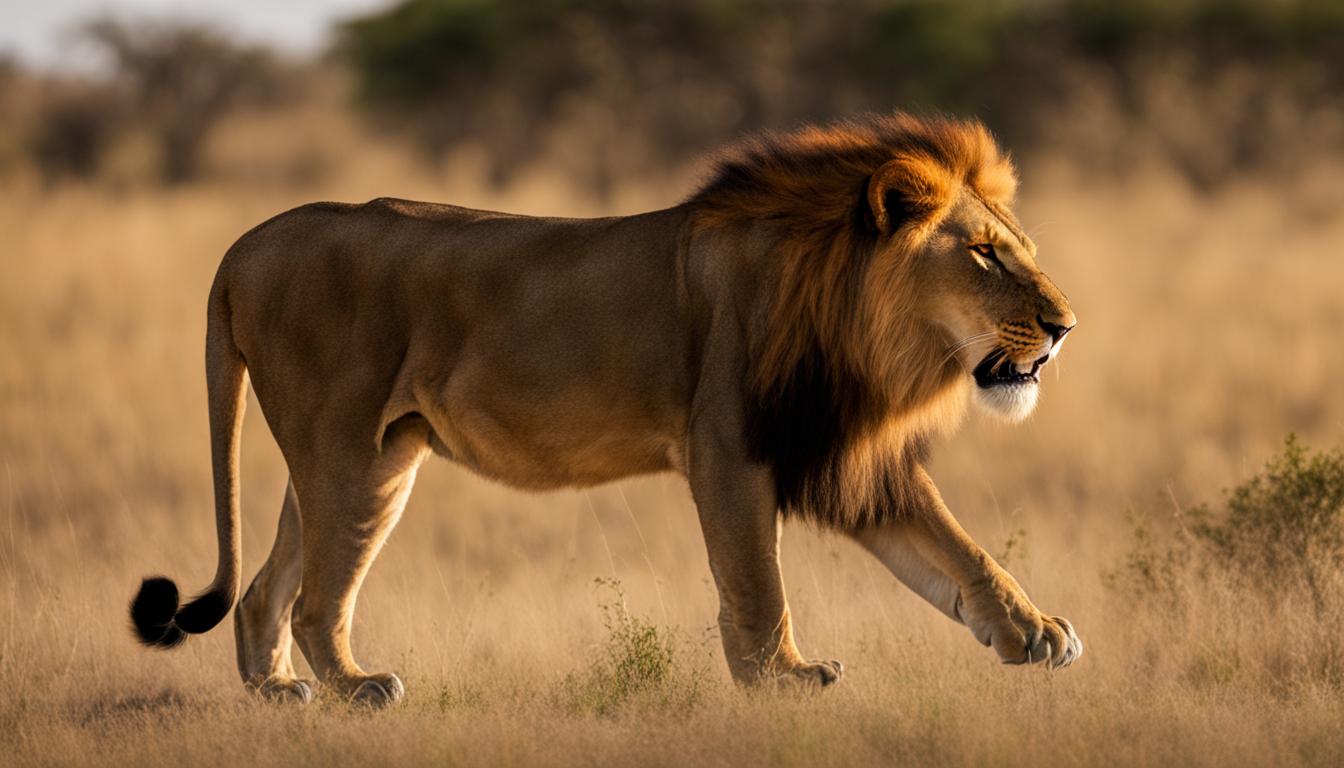Lions have an incredible range of vocalizations, each serving a unique purpose within their social structure and communication system. From powerful roars to subtle purrs, these vocal cues offer fascinating insights into their behaviors and interactions.
Roaring is one of the most iconic vocalizations associated with lions. It is a display of power and dominance, used to assert territorial boundaries and intimidate rivals. Lionesses also possess a medium-pitched roar, which they use to communicate within the pride.
Grunts are another common vocalization heard from lions, serving as everyday communication among pride members. These grunts convey a wide range of emotions and messages, creating a vital means of interaction within the group.
When lions are happy and content, they produce softer sounds such as hums, puffs, purrs, and moans. These gentle vocalizations are used to express affection and happiness within the pride. Lionesses also utilize these sounds to communicate with their cubs.
Growls and snarls are aggressive vocalizations that lions employ to establish dominance within the pride. These short, sharp sounds are often directed towards other members, maintaining order and hierarchy within the group.
Understanding lion vocalizations provides valuable insights into their complex social dynamics and behaviors. The rich vocal repertoire of lions showcases their adaptability and survival skills in the wild.
Key Takeaways:
- Lions have a wide range of vocalizations, including roars, grunts, hums, purrs, moans, growls, and snarls.
- Roaring is a display of power and dominance, used to assert territory and intimidate rivals.
- Grunts serve as everyday communication within the pride, conveying various emotions and messages.
- Hums, puffs, purrs, and moans indicate happiness and affection within the pride.
- Growls and snarls are aggressive vocalizations used to establish dominance within the group.
Lion Roar: The Mighty Call of the Wild
A lion’s roar is an awe-inspiring display of power and dominance, reverberating through the savannah and captivating the imagination. This iconic vocalization is one of the most distinctive sounds in the animal kingdom, serving as a powerful form of communication among lions.
The deep, low-pitched roar of a lion can travel up to 8 kilometers, announcing their presence to other lions and marking their territory. It is primarily the males who possess the ability to produce these resounding roars, which are louder and more resonant than those of lionesses. Roaring serves as a means of asserting dominance and intimidating rivals, ensuring their authority within the pride.
Furthermore, the lion roar is not only a message to other lions but also a warning to potential prey. Lions are most active during the evening and early morning hours, and their roaring behavior is often at its peak during these times. The powerful sound of a lion’s roar can send shivers down the spines of both predators and prey, serving as a reminder of the lion’s prowess as the king of the savannah.
Lion Roar: The Mighty Call of the Wild Table
| Lion Roar | Description |
|---|---|
| Distances Covered | A lion’s roar can be heard up to 8 kilometers away. |
| Resonance | Males have a louder and more resonant roar than lionesses. |
| Purpose | Roaring is used to assert dominance, mark territory, and communicate with other lions. |
| Warning | The roar of a lion serves as a warning to potential prey. |
| Timing | Lions roar most often during the evening and early morning hours. |
Lion Grunts: Everyday Communication Among the Pride
Grunt vocalizations are a common form of communication among lions within a pride. These deep and forceful sounds serve as a way for lions to convey a wide range of emotions and messages to one another. Unlike the powerful roars that are used for dominance and territorial assertion, grunts are everyday vocal cues that facilitate social interaction within the group.
- Lion grunts are louder and more forceful than purrs and meows, making them specific to larger cats like lions.
- These vocalizations can be heard at various volumes and pitches, depending on the specific message being conveyed.
- Some safari guides have even learned to imitate lion grunts and have conversations with the big cats.
Grunts can express a variety of meanings, including greetings, warnings, instructions, and even requests for attention or assistance. They serve as a language that allows lions to maintain social cohesion and hierarchy within the pride. By using grunts, lions can quickly communicate their intentions and feelings, ensuring smooth interactions and cooperation among pride members.
“The grunts of lions are like a secret code, allowing them to navigate their social dynamics effortlessly. It’s fascinating to witness how they use these vocalizations to convey complex messages without uttering a single word.” – Safari guide
Understanding lion grunts provides valuable insight into the intricate social structure and behaviors of these majestic creatures. It showcases their adaptability and intelligence in utilizing different vocal cues to facilitate communication. Grunts are just one piece of the rich vocal repertoire that lions possess, enabling them to thrive and survive in the wild.
| Common Meanings of Lion Grunts | Description |
|---|---|
| Greeting | Lions use grunts to acknowledge and greet other members of the pride. |
| Warning | A forceful grunt can serve as a warning to potential threats or intruders. |
| Request for Attention | By emitting a distinct grunt, lions can seek attention or assistance from other pride members. |
| Instruction | Grunts can be used by dominant lions to instruct and direct the behavior of other pride members. |
| Expression of Dominance | In certain situations, lions may use grunts to assert their dominance within the pride hierarchy. |
Overall, lion grunts play a crucial role in lion communication, facilitating everyday interactions and maintaining social order within the pride. These vocal cues allow lions to navigate their complex social dynamics with precision, ensuring their survival and success as a cohesive group.
Hums, Puffs, Purrs, and Moans: Happy Lion Sounds
While lions are often known for their powerful roars, they also have a softer side when it comes to communication. When lions are happy and content, they produce a range of gentle sounds such as hums, puffs, purrs, and moans. These subtle vocalizations serve as a way for lions to express affection and happiness within the pride.
Lionesses, in particular, use these happy lion sounds to communicate with their cubs, creating a bond and fostering a sense of security. These soft sounds are also a unique way for lions to interact without attracting the attention of potential prey or rivals. It’s a form of communication that is exclusive to these magnificent creatures.
These happy lion sounds play an essential role in the social dynamics of a pride. They create a sense of unity and strengthen the bonds between pride members. Just like humans express happiness through laughter or gentle words, lions have their own version of expressing joy, and it’s through their hums, puffs, purrs, and moans.
Happy Lion Sounds in Comparison:
| Vocalization Type | Description |
|---|---|
| Hums | Low-pitched and rhythmic sounds that indicate contentment and relaxation. |
| Puffs | Short and quick bursts of sound that express playfulness and amusement. |
| Purrs | Soft, vibrating sounds that signify happiness and affection within the pride. |
| Moans | Deep, melodic vocalizations that convey a sense of comfort and satisfaction. |
These happy lion sounds are a testament to the complexity of their communication and the depth of their emotions. It’s a reminder that even the mightiest of creatures have their softer moments, where joy and contentment fill the air.
Lion Growls and Snarls: Dominance Within the Pride
While roaring is often associated with lion dominance, growls and snarls play an equally important role in asserting power within the pride. These aggressive vocalizations are directed at other members of the group, particularly when a male lion is dissatisfied with the behavior of another lion. By using short, sharp growls and snarls, lions maintain order and hierarchy within the pride.
“Growling and snarling are ways for lions to communicate their dominance and establish boundaries,” says Dr. Jane Simmons, a wildlife biologist. “It’s like a lion’s way of saying, ‘I’m in charge here, and you better listen.’”
Lion growls are deep and guttural, while snarls are characterized by the baring of teeth and a more aggressive tone. These vocal cues serve as clear warnings to other pride members, signaling submission and respect. By using growls and snarls strategically, lions establish their dominance and prevent potential conflicts from escalating.
“The vocal patterns of growls and snarls in lions are distinct and specific,” explains Dr. Sarah Richards, a renowned zoologist. “Each growl and snarl carries a different meaning, whether it’s a warning, a command, or a display of dominance.”
Table: Lion Vocal Repertoire
| Vocalization | Description |
|---|---|
| Roar | Powerful, low-pitched call used to assert dominance and defend territory. |
| Growl | Deep, guttural vocalization indicating dominance and hierarchy within the pride. |
| Snarl | Aggressive vocal cue characterized by bared teeth and a more intense tone. |
| Purr | Soft, contented sound used to express happiness and affection within the pride. |
| Moan | Gentle, subtle vocalization indicating contentment and relaxation. |
In summary, lion growls and snarls are essential vocal cues that contribute to the social dynamics and hierarchy within a pride. These vocalizations are used by lions to assert dominance, establish boundaries, and maintain order. By understanding the significance of growls and snarls, we gain valuable insights into the fascinating world of lion communication and behavior.
Conclusion
Lions have a rich vocal repertoire, using a variety of sounds to communicate with each other. From powerful roars to gentle purrs, each vocalization serves a specific purpose within the pride. Roaring is a show of dominance, while grunts are everyday communication. Hums, puffs, purrs, and moans indicate happiness, and growls and snarls establish dominance within the group.
Understanding lion vocalizations sheds light on their complex social structure and behaviors. These vocal cues play a crucial role in maintaining order, asserting dominance, and expressing affection within the pride. Lions have evolved with the unique ability to communicate through a range of sounds, showcasing their adaptability and survival in the wild.
Next time you hear a lion roar or witness a pride communicating with various vocal cues, remember the intricate web of communication that lies behind it. The diverse vocal repertoire of lions is a testament to their remarkable abilities and the fascinating world of animal communication.
Do African Grey Parrots have similar vocalizations to lions?
African grey parrots and their decibel levels cannot match the sheer vocal power of lions. While African Grey Parrots are known for imitating various sounds with precision, lions possess incredibly loud roars that can be heard from far distances. These majestic big cats have vocalizations that communicate their dominance and territoriality, making them unmatched in the animal kingdom.
FAQ
What are the various vocalizations used by lions?
Lions have a wide range of vocalizations, including purrs, grunts, growls, hums, meows, roars, and moans.
Why do lions roar?
Roaring is a show of power and dominance, used to assert their territory and intimidate rivals.
Do lionesses roar?
Yes, lionesses also have a medium-pitched roar.
What is the purpose of grunts in lion communication?
Grunts are everyday communication within the pride, used to convey a wide range of emotions and messages.
What do lion hums, puffs, purrs, and moans indicate?
These softer and subtler sounds indicate happiness within a pride and are used to express affection and happiness.
How do lions show dominance within the pride?
Lions use short, sharp growls and snarls to assert their dominance within the pride.










